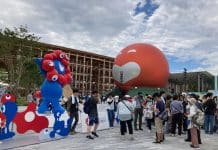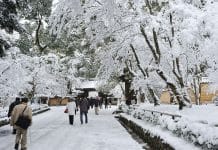Table of Contents
Introduction
Osaka in the year 1614. Mohei (Toshiro Mifune), a wandering, masterless samurai arrives in the city and immediately gets into troubles due to his irascible nature. While Mohei battles it out with enraged hordes of locals and the men led by a mysterious mountain samurai, the mood is dark at Osaka Castle, the seat of the Toyotomi clan.

Great warrior Toyotomi Hideyoshi had unified large parts of Japan under his rule; Hideyoshi had built the castle (completed in 1597) and established it as the headquarters of Japan’s most powerful clan.
But after Hideyoshi’s death in 1598, his former vassal Tokugawa Ieyasu, the daimyo of Edo in Eastern Japan, had usurped power and established himself as Shogun, taking on the mantle of de facto ruler of all of Japan.
Yodogimi (Isuzu Yamada), Hideyoshi’s widow and guardian of his son Toyotomi Hideyori, laments the developments in a bitter speech in the great hall of Osaka Castle. How Ieyasu had just stripped Hideyori of the title of kampaku (regent in the direct service of the Emperor) and degraded him to the status of regular daimyo (local ruler) under direct control of the Tokugawa shogunate.

Hideyori (Hanshiro Iwai) sits quietly by when Yodogimi announces her strong opposition to Ieyasu, her call to arms against the Tokugawa shogunate. His wife Senhime (Yuriko Hoshi) however immediately starts pulling strings. She is, after all, not only the wife of Toyotomi Hideyori but also the grand-daughter of Tokugawa Ieyasu. Through secret channels, she tries to calm down the frictions between the two powerful clans. She doesn’t want war between them… after all, she belongs to both of them.

Mohei loses his fight against the men of the mountain samurai. They bind him and suspend him from a bridge on a rope. Just then, out of nowhere, a ninja appears, cutting the rope. Below, a girl in a boat rescues Mohei and takes him to her hide-out.
The girl, Ai (Kyoko Kagawa), is a servant and close confidant of Senhime and she soon convinces Mohei to work on Senhime’s behalf. In fact, Mohei doesn’t care much about Senhime or politics in general. But he is in instant love with Ai and willing to do anything she asks him to do.

On Ai’s behest, Mohei secretly enters Osaka Castle through a scary tunnel full of bats and snakes. In the castle yard, he has his share of fights and he witnesses women trying to kill each other.
Safely back at Ai’s place, he finds out that the house belongs to a merchant who does secret firearms deals with the Portuguese ships anchored in Osaka Bay.
Daredevil in the Castle (Japan, 1961) 大阪城物語
The list of characters expands, the intrigues get murkier by the minute. Who is who and on which side are they? Things get quite confusing. So much so that in a 1969 movie review the New York Times called the film an “Inscrutable Horse Opera”.
In some English-speaking territories, the film was shown using the direct translation of its Japanese title: The Story of Osaka Castle (Osaka-jo Monogatari).

Eventually, the merchant, Mohei and others enter the Portuguese flag ship. Firearms for gold is the deal but the merchant has a special bonus on offer: he had Ai kidnapped and now presents her to the Portuguese, locked up in a box.

This, of course, doesn’t go over well with Mohei. A big brawl erupts on the ship. Will Mohei and Ai make it to shore safely?
Then, suddenly, the film shifts in style from samurai drama to grand American Western.
Mohei needs to deliver those Portuguese guns to Osaka Castle. Quickly. Tokugawa Ieyasu’s forces are about to attack the castle and those forces are arriving in very large numbers.
Mohei races his horses pulling the carts with the firearms through an impressive landscape like he is with the 7th Cavalery. Finally, it makes sense that the film was shot in cinemascope! Will those arms save the castle from the Tokugawa army?
Historical Aftermath
The movie has quite an upbeat ending. In real history, however, Tokugawa Ieyasu’s troops burned the castle to the ground in a second attack the following year and totally destroyed the Toyotomi clan.

Soon after, Ieyasu himself ordered the castle to be rebuild and he planned to make that new castle his seat of power and thus Osaka the capital of Japan. He died in 1616 however, long before the completion of the new castle. His descendants liked life in Edo far too much to follow up with his plan.
If Ieyasu had had the chance to go through with his plan, nobody would talk about the Edo Era today, it would be the Osaka Era. Osaka would still be the capital today. Edo would just be a small town somewhere south of Ibaraki Prefecture. Tokyo would never exist.
Toshiro Mifune

Toshiro Mifune is the central actor and star of the movie. Starting out as an angry lone samurai, his character undergoes many transitions throughout the movie. Mifune plays the perfect lover, the dedicated fighter, the quick-witted talker and at times, his character comes off as quite comical. He is most impressive as the grand hero rescuing the castle in the final half hour.
There is some debate among critics whether his frequent change in acting styles was intended by the screen writers or if it was Mifune’s reaction to a confusing script. In any case, Mifune played all the different scenes perfectly, showing off his great versatility as a character actor.
Toshiro Mifune was born in 1920 in then Japanese-occupied Qingdao, China. His father was a photographer and Japanese Methodist missionary, his Japanese mother was also engaged in Christian missionary work. Mifune spent most of his youth in Dalian, Liaoning Province, China. Becoming a photographer like his father was his goal.
In World War II, Mifune, being a Japanese citizen, was drafted into the Japanese Imperial Army, serving as aerial photographer.
In 1947, the Toho Studio in Tokyo started a massive campaign for “new faces”. Mifune applied – wanting to become a cameraman. When that didn’t work out, he also went to actors’ auditions. Being very good-looking, muscular and having an obvious talent for acting, Mifune soon joined Toho in front of the camera rather than behind.
Mifune quickly rose through the ranks and was soon considered one of the best actors in Japan.
Especially his work with director Akira Kurosawa drew attention. There, he was able to introduce a totally new character to Japanese cinema – the rogue samurai. Rough and gruff but (usually) with a heart of gold.
That was a quite a departure from the previous samurai seen on screen, all stylized and derived from refined kabuki plays. Mifune offered the real gritty deal.
For his roles in films like Rashomon (1950), Seven Samurai (1954) and Yojimbo (1961), Mifune won prestigious international awards at the festivals in Venice and elsewhere. Altogether, Mifune made 16 films with Kurosawa until their ways parted in the mid-1960s.
Starting with a Mexican movie made in 1962 (Ánimas Trujano, nominated for an Academy Award), Mifune became involved with the international film world. His role as Formula 1 racing team owner in John Frankenheimer’s 1966 film Grand Prix was his Hollywood debut.
While continuing his work in Japanese cinema, Mifune also acted alongside Charles Bronson, Alain Delon and Ursula Andress in the 1971 Spaghetti Western Red Sun and in various Hollywood World War II movie productions including Steven Spielberg’s 1941 (1979).
The greatest fame in the West he earned however for his role in the 1980 American historical TV drama Shogun.
The TV miniseries recounts the arrival of English sailor William Adams on a wrecked Dutch ship in Japan in 1600. After a time of hardships, Adams is eventually called in for a meeting with a powerful daimyo. The two of them strike up a friendship. The daimyo, Tokugawa Ieyasu, soon becomes the Shogun of Japan and due to his support, Adams became a high-ranking Japanese samurai with a large property in Ito, in today’s Shizuoka Prefecture.
The details of that story are fictionalized in the TV series, a John Blackthorne (Richard Chamberlain) stands in for William Adams, Lord Toranaga (based on Tokugawa Ieyasu) is his grand protector. Toshiro Mifune played Lord Toranaga.
The Shogun TV series turned into a smashing success. Broadcast network NBC achieved with it the highest viewership in its history; the series is rated as having the 2nd highest viewership in American TV history (after Roots, 1977). Reportedly, movie theaters noted a sharp decline in audiences when Shogun was on air – people preferred to stay at home to follow the series on TV. The series also ushered in a first boom of Japanese cuisine in the U.S. Especially sushi restaurants are said to have opened in its wake in big cities across the country.
Mifune remained active in Japanese and international movie productions until 1995. He died in Mitaka, Tokyo in 1997. In 2016, he received a star on the Hollywood Walk of Fame.
The Director
Daredevil in the Castle was directed by Hiroshi Inagaki (1905 – 1980). The son of a stage actor, Inagaki appeared on stage and in silent movies already as a child. At age 22, he made his debut as director, at quite an unusually young age for a director of his generation.
Inagaki focused on jidaigeki historical dramas from early on and he stayed with the genre throughout his career, directing more than 90 films.
Jidaigeki historical dramas were most popular during the 1950s and 1960s and it was in those times that Inagaki had his biggest success.
From 1954 to 1956, he directed his Samurai Trilogy. Part One of the series, Samurai 1: Miyamoto Musashi, won an Academy Award for Best Foreign Language Film. The titular hero was played by Toshiro Mifune – who also played the hero in the other two parts of the trilogy.
In 1958, Inagaki’s Rickshaw Man won a Golden Lion at the Venice Film Festival. Again, the star of the movie was Toshiro Mifune.
Altogether, Inagaki directed Mifune in 20 films.
Eiji Tsubaraya
Eiji Tsubaraya (1901 – 1970) was in charge of the special effects of Daredevil in the Castle. Tsubaraya, who had learned his craft creating the special effects for Japanese propaganda movies during World War II, was the man who had created Godzilla and who built all the scale models of the cities Godzilla destroys in the early entries of the Godzilla franchise.
Daredevil in the Castle was a Toho production just as Godzilla was. Tsubaraya was on the payroll of Toho for most of his career. The studio tasked him with a great number of set designs, be they scale models as in the Godzilla movies or life-size historical settings as in Daredevil in the Castle.

Tsubaraya did a great job creating the small historical Osaka neighborhood centered on a bridge where much of the outdoor action is taking place. When it came to a large panorama of the city burning, however, his real talents finally come to the fore.
Osaka Locations
Real footage of Osaka Castle and its walls is frequently shown in the movie. The original Osaka Castle Toyotomi Hideyoshi built was however different from the one that Tokugawa Ieyasu later built in the same location. Osaka Castle was severely damaged in the Boshin War (1868 – 1869) as well as in the American bombing campaigns towards the end of World War II.
Drawing on historical depictions, Tsubaraya appears to have opted for a version of the castle that embodies both the appearance of the castle in historic times as well as the castle Osakans and tourists to the city were familiar with at the time of the film’s release.




















